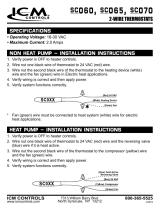
9
Defrost Control Board
Operational Information
• Terminals R - RC must have 24±V present between
them in order for the time delay and defrost sequences
to be operational.
• JumperingtheT2-DFT test pins will communicate to the
board that the defrost T-stat is closed (if compressor is
running). The defrost thermostat tells the board whether
a defrost cycle needs to be started or terminated.
NOTE: The defrost T-stat is closed at 32° F or below
and is open at 68° F or above, but it’s state is unknown
if the temperature is between 32° F & 68° F.
• With the DFT closed, the unit will run for 30/60/90
minutes in heat mode and then defrost the outdoor
coil. The defrost will turn off the outdoor fan, turn on the
compressor and raise the coil temperature to 68° F. This
will open the DFT and terminate the defrost. If the DFT
does not open the defrost will end after 10 minutes.
• Toover-ridethedefrostboarrdandinitiateafasterdefrost
test in 5, 10 or 15 seconds as determined by the 30, 60
or 90 minute defrost pin settings (factory setting is 30
minutes), jumper the TEST terminal to the C (common)
terminal while the compressor is in heat mode.
– This will bypass the compressor off delay when the
unit goes into defrost test and if left in defrost test, the
delay will be bypassed when the test is terminated
by the processor. NOTE: If the jumper is removed
before the test is over, the processor will perform the
remainder of a normal defrost. See bullett 2 above.
• To switch from no-delay to delay, remove the pin from
the no - delay pin location and shift it to the delay pin
location. The delay/no-delay pin concerns compressor
operation during defrosts. The default setting is delay.
– Reciprocating compressors should only use this
setting in conjunction with an approved hard start
kit.
– Scroll compressors that have noise issues while
going into or coming out of defrost should use this
30 second delay to reduce the defrost noise.
– Manually initiating a defrost will cause the compressor
to run continually when entering defrost.
Normal defrost operation
To test normal defrost operation when the temperature is
above 35° F, jumper R to DFT on the board and allow the
unit to run for 30 minutes. Defrost will continue until the
R to DFT jumper is removed or for 10 minutes. Remove
the jumper.
The 5 minute time delay feature can be shortened 1 time
to 1 second by jumping the Test to C terminal. Remove
the jumper and repeat as desired.
NOTE: If jumper is left on the Test to common pins
permanently, the defrost cycle will become inoperable.
Defrost Test Procedure
1. Jumper T2 to DFT at the test terminals.
2.Withunitrunninginheatmode,shorttheTEST terminal
to the common terminal near it. This will speed up the
board and cause it to enter defrost mode in 5/10/15
seconds depending on the defrost time selection.
Compressor delay will not function during speed-up.
3. This test will end in 5 seconds if the TEST-common
short is not removed.
4. Remove both the short and the T2 to DFT jumper to
terminate the defrost cycle. The 30 second compressor
delay should operate normally.
5. Test is complete, reset thermostat to home owner
preference.
Anti Short Cycle Timer Test
The 5 minute time delay feature can be bypassed or
shortened to 1 second by jumping the Test to C terminal.
NOTE: If jumper is left on the Test to common pins
permanently, the defrost cycle will become inoperable.
HEAT PUMP MAINTENANCE
WARNING:
To prevent electrical shock, personal injury, or
death, disconnect all electrical power to the unit
before performing any maintenance or service.
The unit may have more than one electrical
supply.
Proper maintenance is important to achieve optimum
performance from the heat pump. The ability to properly
perform maintenance on this equipment requires certain
mechanical skills and tools. If you do not possess these
skills, contact your dealer for maintenance. Consult your
local dealer about the availability of maintenance contracts.
Routine maintenance should include the following:
• Inspectandcleanorreplaceairltersatthebeginning
of each heating and cooling season, or more frequently
if required.
• Inspecttheoutdoorcoilatthebeginningofeachcooling
season. Remove any debris. Clean the outdoor coil
and louvers as necessary using a mild detergent and
water. Rinse thoroughly with water.
• Inspecttheelectricalconnectionsfortightnessatthe
beginning of each heating and cooling season. Service
as necessary.
CAUTION:
The unit should never be operated without a
filter in the return air system. Replace disposable
filters with the same type and size.
• Donotaddadditionaloiltomotorsunequippedwith
oil tubes. The compressor is hermetically sealed at the
factory and does not require lubrication.




















